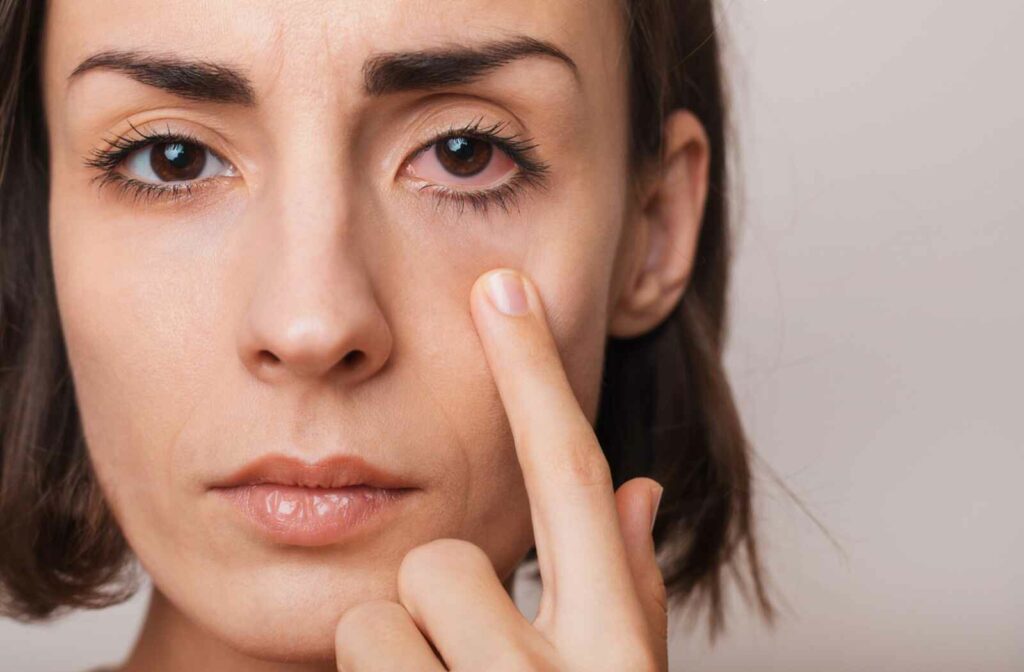Despite our humid Floridian climate, dry eye disease is prevalent. Dealing with dry, irritated eyes in a humid climate can be especially frustrating because it seems to be out of your control. If you’re one of the many people diagnosed with Meibomian Gland Dysfunction (MGD), you know this struggle all too well.
Fortunately, MGD can be treated with home remedies like a warm compress, prescribed lubricants or anti-inflammatory medications. Your optometrist can help recommend the most effective combination treatments for your eyes.
What is Meibomian Gland Dysfunction?
Meibomian Gland Dysfunction, commonly called MGD, is a prevalent eye condition affecting the tiny glands lining your eyelids. These glands produce the oily layer of your tears, which prevents your eyes from drying out. When these glands become blocked or dysfunctional, it can lead to uncomfortable symptoms.
Symptoms of MGD
MGD often manifests itself through various symptoms, making it difficult to diagnose initially. Common symptoms include:
- Dry eyes
- A gritty or burning sensation
- Blurry vision
- Eyelid inflammation
- Crusty bits on your eyelids
These symptoms can vary in severity and may be mistaken for other eye conditions, making proper diagnosis crucial.
Causes of MGD
The causes of Meibomian Gland Dysfunction can be multifactorial. Hormonal changes, certain medications, and skin conditions like rosacea can contribute to gland dysfunction. Additionally, lifestyle factors such as prolonged screen time and inadequate blinking can exacerbate the condition.
Diagnosing MGD
Diagnosing MGD involves a comprehensive eye exam conducted by an eye care professional. This exam may include assessing the quality of your tears, examining your eyelids, and using specialized imaging technology to evaluate the condition of your meibomian glands. Proper diagnosis is the first step toward effective management.
Can Meibomian Gland Dysfunction Be Reversed?
One of the most common questions people with MGD ask is whether the condition can be reversed. While complete reversal of MGD may not always be possible, many individuals experience significant improvement with appropriate treatment. The key is early intervention and consistent management. Addressing the condition promptly can prevent further damage to the glands and enhance the chances of restoring their function.
Several factors influence the potential for reversing MGD. These include the severity of the condition, the underlying causes, and the effectiveness of the chosen treatment plan. Working closely with your eye care provider to tailor a treatment approach that suits your specific needs is important.
How to Treat Meibomian Gland Dysfunction

Treating Meibomian Gland Dysfunction involves a combination of home remedies, medical treatments, and lifestyle adjustments.
Home remedies can be highly effective in alleviating MGD symptoms. Your optometrist may suggest:
- Applying a warm compress to your eyelids to liquefy the glands’ oils, allowing them to flow more freely
- Giving yourself gentle eyelid massages
- Regularly cleaning your eyelashes and lids with mild soap
- Reducing prolonged screen time
- Taking omega-3 supplements
- Using over-the-counter artificial tears or lubricating eye drops
Medical treatments may be necessary for more severe cases of MGD. Your eye care provider may recommend prescription eye drops or ointments to reduce inflammation and promote gland function. In-office procedures such as LipiFlow, which uses heat and pressure to unclog glands, can provide significant relief. Intense Pulsed Light (IPL) therapy is another option that has shown promising results in managing MGD.
How Long Does It Take to Treat Meibomian Gland Dysfunction?
The timeline for treating MGD can range from a few weeks to several months. Several factors can influence how long it takes to treat MGD. These include the severity of your condition, the effectiveness of your chosen treatments, and your overall eye health. Lifestyle factors like screen time and environmental conditions can also impact recovery speed.
Consistency is key. Sticking to your treatment regimen and diligently following your eye care provider’s recommendations is essential. While some individuals may experience rapid improvement, others may require more time to see significant changes.
It’s important to give your treatments time to work and avoid becoming discouraged if you don’t see immediate results. Regular follow-up appointments with your eye care provider can help track your progress and make any necessary adjustments to your treatment plan.
What is the Best Treatment for Meibomian Glands?
Finding the best treatment for your meibomian glands may require trial and error. Often, a combination of treatments yields the best results. This can include a mix of home remedies, over-the-counter products, and medical interventions. For example, applying warm compresses daily, using lubricating eye drops, and undergoing in-office procedures can work synergistically to improve gland function.
In recent years, advanced therapies such as LipiFlow and IPL have gained popularity for their effectiveness in managing MGD. LipiFlow uses heat and gentle pressure to clear blocked glands, while IPL reduces inflammation and promotes healthy gland function. A trained eye care professional typically performs these treatments in the office.
Ultimately, the best treatment for MGD is tailored to your specific needs. Working closely with your eye care provider, you can develop a personalized treatment plan that addresses the underlying causes of your condition and provides optimal relief.
EyeQ Optical understands that MGD can be challenging, but we are dedicated to helping you manage all your dry eye disease symptoms. Contact us today to see how we can help you find relief.




